Smart Home Technologies - One Protocol to Rule Them All?


Introduction to Smart Home Technologies
Smart home devices are becoming more popular and affordable. But, the array of different wireless technologies that enable these devices to communicate with each other and with your smartphone can be confusing. These technologies are protocols or standards, and they all have different features, benefits, and drawbacks. Some of the most common protocols include Wi-Fi, Thread, Matter, Zigbee, Amazon Sidewalk, Z-Wave, Bluetooth, and proprietary. In this blog post, we compare these smart home technologies to help you decide which one is best according to your needs and preferences.
Wi-Fi
Wi-Fi is the most widely used and familiar technology for connecting smart home devices. It uses the same wireless network that you use for your laptop, tablet, or phone, and it offers high-speed data transfer and wide coverage. Wi-Fi is compatible with most smart home devices and platforms, such as Amazon Alexa, Google Assistant, Apple HomeKit, and Samsung SmartThings. Wi-Fi operates on the 2.4 GHz and 5 GHz frequency bands and can support data rates up to several gigabits per second.
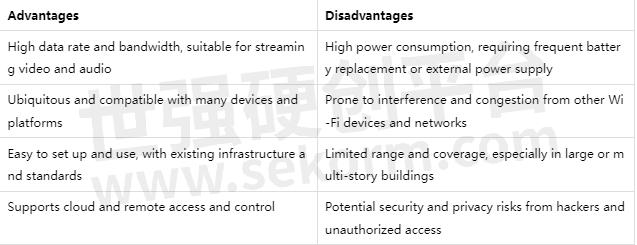
Use Cases:
Lined-powered device and battery powered devices (higher capacity primary cell batteries i.e, alkaline)
·Smart speakers, smart displays, smart TVs, and smart cameras
·Smart thermostats, smart locks, and smart doorbells
·Smart plugs, smart switches, and smart bulbs
Wi-Fi Mesh Use Cases:
Wi-Fi Mesh can improve the connectivity and functionality of smart home devices, especially those that are located outdoors or far from the router. This includes devices like security cameras, smart lights, or pet trackers, which benefit from the extended network coverage provided by Wi-Fi Mesh.
Wi-Fi Mesh is also suitable for outdoor lighting, sensing, and control, park management, environmental management, building and campus management, and even applications in airports.
Thread
Thread is a low-power, mesh-based smart home protocol. It uses the same frequency band as Wi-Fi, but it creates a separate and dedicated low power mesh network. Thread devices use a robust mesh networking to cover home and even commercial buildings. Thread does not define an application layer, so manufacture’s need to develop their own or may be able to support an existing ecosystem like Apple HomeKit.
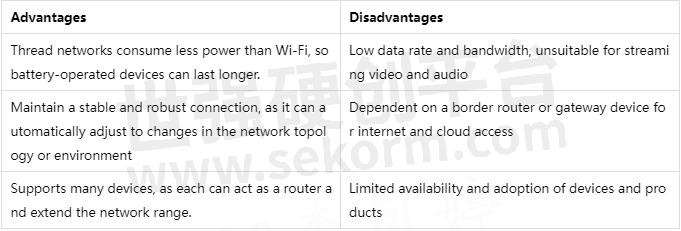
Use Cases:
Lined-powered device and battery powered devices (coin cell batteries)
·Smart sensors, such as motion, temperature, humidity, and light sensors
·Smart switches, smart plugs, smart lights
·Smart locks
Beyond the Door Thread Applications
·Sensor networks, asset ttracking, and control systems
·Street lighting control, environmental monitoring, and traffic management
·Garden automation, pool monitoring, and outdoor lighting
Matter
Matter is a new smart home protocol that was released in 2022 by the Connectivity Standards Alliance, a group of tech companies that includes Amazon, Apple, Google, Samsung, SILICON LABS, and many others. Matter aims to create a universal and interoperable standard for smart home devices, regardless of the brand, platform, or technology.
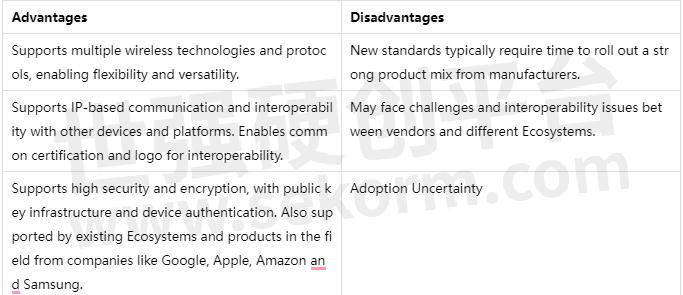
Use Cases:
Lined-powered device and battery powered devices
·Smart speakers, smart displays, smart TVs, and smart cameras
·Smart thermostats, smart locks, and smart doorbells
·Smart plugs, smart switches, and smart bulbs
·Smart sensors, smart buttons, and smart remotes
·Smart appliances and white goods
The diagram below shows which applications are best served by Matter over Thread or Matter over Wi-Fi.

Zigbee
Zigbee is one of the oldest and most established smart home protocols, used by many popular brands including Philips Hue, Ikea, and Honeywell. It’s also a low-power and mesh-based protocol that operates on the same frequency band as Wi-Fi, but it uses a different modulation and coding scheme. Zigbee devices can form a network of hundreds of nodes, and they can communicate with each other or with a central hub or coordinator. Zigbee is directly supported by some smart home platforms, including Amazon Echo and Samsung SmartThings, and Tuya and can be enabled to work with others, such as Google Nest and Apple HomeKit through Actions or Skills.
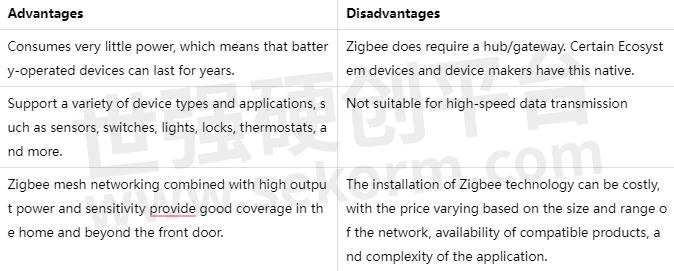
Use Cases:
Lined-powered device and battery powered devices (coin cell batteries)
·Smart sensors, such as motion, temperature, humidity, and light sensors
·Smart switches, smart buttons, smart plugs, and smart lighting
·Smart locks
·Smart meters
Beyond-the-door Zigbee Applications
·Sensor networks, asset tracking, and control systems
·Street lighting control, environmental monitoring, and traffic management
·Garden automation, pool monitoring, and outdoor lighting
Amazon Sidewalk
Amazon Sidewalk launched in 2021 and offered a, smart home protocol that enables shared wireless networks connecting IoT devices at homes, beyond the front door, neighborhood, and city.
It’ is a long-range and low-bandwidth protocol that uses the 900 MHz (long range) and 2.4 GHz Bluetooth Low Energy (LE) (In Home) to connect smart home devices and extend their network coverage. Amazon Sidewalk uses two modulation techniques to transmit data over 900 MHz band: frequency-shift keying (FSK) and chirp spread spectrum (CSS). FSK is used by Amazon Sidewalk for medium-range communication between Amazon Sidewalk Bridge devices, such as Echo or Ring, and Amazon Sidewalk-enabled devices. CSS can provide longer range than FSK but much lower data rates. By using FSK and CSS, Amazon Sidewalk can create a reliable and secure wireless network that covers a large area and supports a variety of low-power devices.
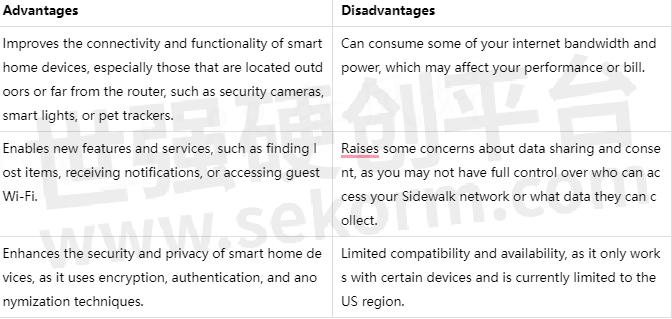
Use Cases:

Z-Wave
Z-Wave is a low-power, mesh network protocol that operates on the 800-900 MHz frequency band widely used in smart home devices, especially for security, lighting, and climate control. It was developed by the Z-Wave Alliance, which includes more than 300 companies that produce Z-Wave compatible devices.
Z-Wave is designed to be reliable, scalable, and secure. It uses a mesh network topology, which means that each device can act as a repeater and extend the range of the network. It also uses encryption and device authentication to prevent unauthorized access and hacking. A Z-Wave network can handle a maximum of 232 devices (nodes) including the primary controller.
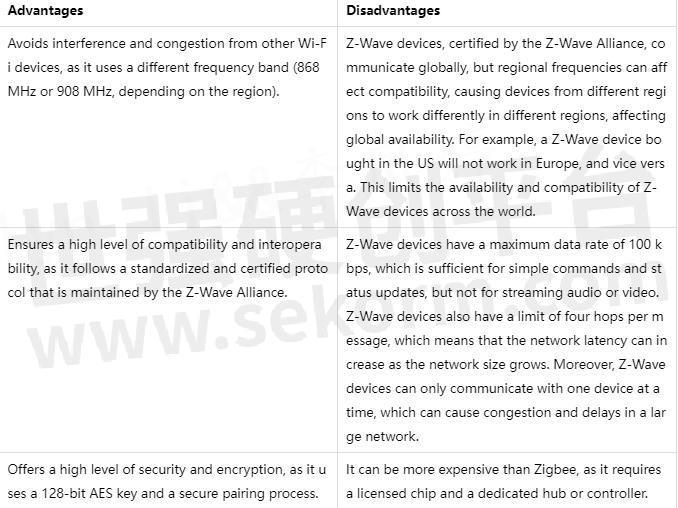
Use Cases:
Z-Wave in Home : Lined-powered device and battery powered devices (coin cell batteries)
·Smart sensors, such as motion, temperature, humidity, and light sensors
·Smart switches, smart plug
·Smart locks, smart doorbells, and smart security systems
Z-Wave LR
·Z-Wave LR can support more devices in a single network, up to 4,000 nodes, allowing users to add more smart home features and functionalities to their homes. This also enables multi-dwelling property managers to cover a building or complex on a single network
·Z-Wave LR enables wireless connectivity for sensors, door locks, and lighting without the need for repeaters or extenders. It can cover larger areas like gardens, driveways, or backyards, and provide more reliable communication in harsh weather conditions.
Bluetooth LE
Bluetooth LE is another common and familiar technology predominately used for connecting devices to phones. It uses the same frequency band as Wi-Fi, but it has a shorter range and a lower data rate. Bluetooth devices can communicate with each other or with a smartphone or tablet, and they can form a network of up to seven devices, called a piconet. Typical smart home devices are locks and lighting that use the phone for in home control. Bluetooth requires a hub for control outside of the home.

Use Cases:
·Wireless headphones, speakers, and earbuds
·Wireless keyboards, mice, and game controllers
·Smart watches, fitness trackers, and health monitors
·Smart tags, trackers, and beacons
Bluetooth Mesh
Bluetooth mesh is a network topology that allows Bluetooth devices to relay messages to each other, forming a mesh network. This means that Bluetooth devices can communicate with each other without relying on a central hub or router and can cover a larger area and support more devices. Bluetooth mesh also offers features such as self-healing, scalability, security, and low power consumption.
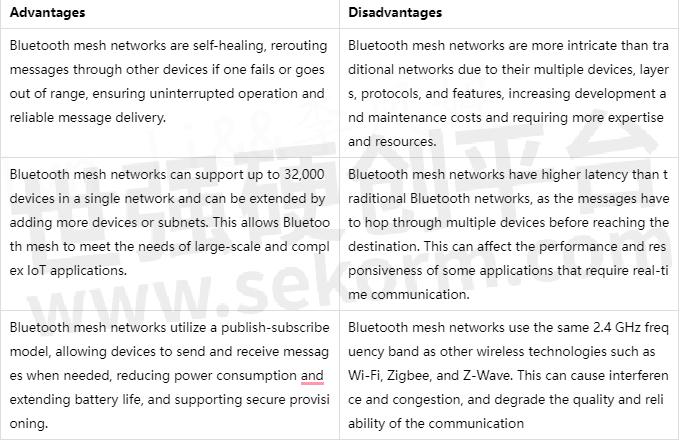
Use Cases:
·Smart lighting
·Building automations
·Asset tracking
·Environmental monitoring
Proprietary (Sub-GHz and 2.4 GHz)
Proprietary wireless technologies can operate on different frequency bands, such as Sub-GHz or 2.4 GHz, and can support different data rates and bandwidths, depending on the vendor or manufacturer. Proprietary wireless devices can form different network topologies, such as star, tree, or mesh, depending on the vendor or manufacturer. Proprietary networks require their own hub or gateway and don’t have direct connections to ecosystems. Proprietary wireless devices can be enabled to work with ecosystems, such as Google Nest and Apple HomeKit through Actions or Skills.
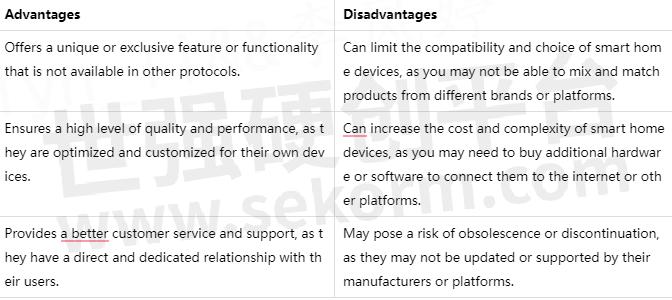
Use Cases:
·Proprietary smart sensors, smart buttons, and smart remotes
·Proprietary smart locks, smart doorbells, and smart security systems
·Proprietary smart meters, smart plugs, and smart appliances
How to Determine the Best Smart Home Technology
As you can see, there is no single or best smart home protocol or standard, as each one has its own strengths and weaknesses, and they may suit different needs and preferences. The below table shows the summary of all protocols.
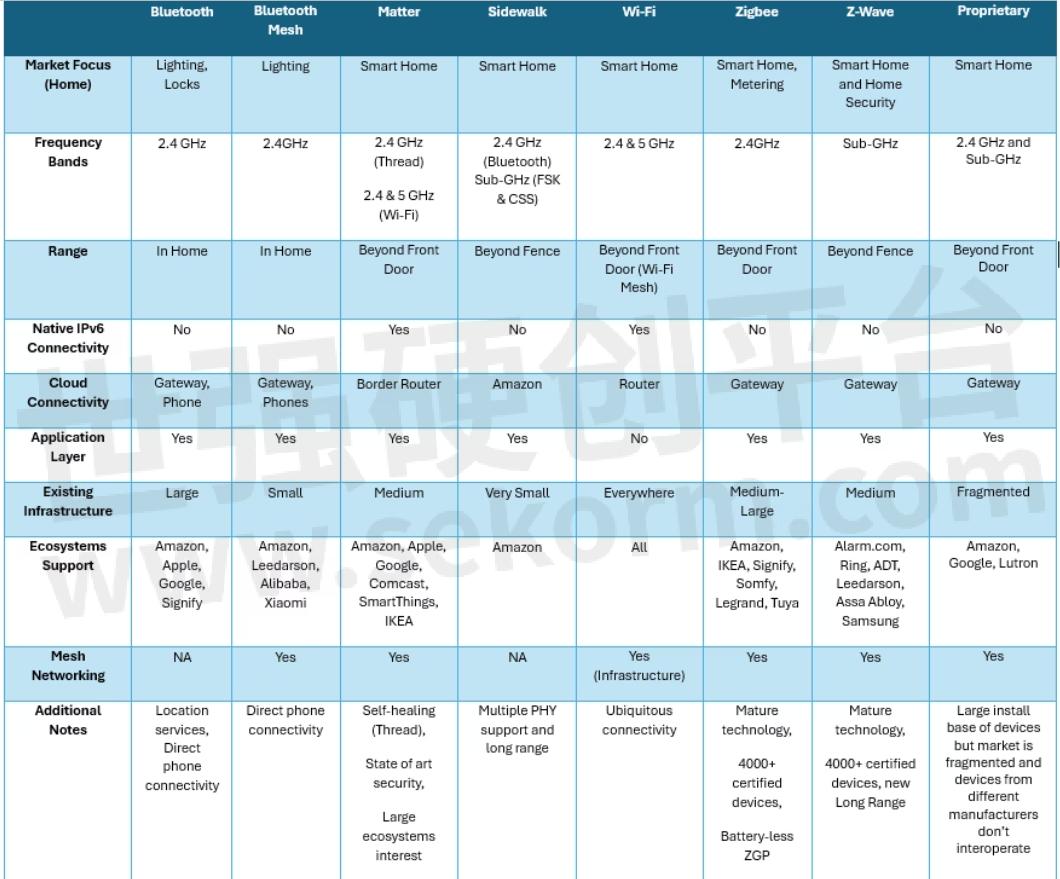
By answering the following questions, you can find the best smart home protocol or standard for your smart home.
Which smart home technology should I use if I want to add more smart home devices in future?
·To future-proof your smart home and ensure compatibility with a growing number of devices, Wi-Fi technology is a strong choice. Wi-Fi’s ubiquity and compatibility with many devices make it a versatile and scalable option.
Which smart home technology should I use if I have to consider the compatibility and interoperability of smart home devices with your existing or preferred platforms, voice assistants, or apps?
·Matter is the best choice.
Which smart home technology is the best if I want more range and coverage of smart home devices in my home or outdoor area?
·Z-Wave technology is indeed a strong contender for smart home technology that requires extended range and coverage. Z-Wave operates on a Sub-GHz frequency band, which allows for a mesh network where each device can act as a router or repeater to extend the network’s range and coverage.
·Amazon Sidewalk can also be considered.
Which smart home technology uses less power consumption and has more battery life while considering for smart home devices?
·Zigbee is highlighted for its low-power and low-data-rate wireless technology designed for applications that require long battery life, network reliability, and security. Zigbee devices can form a mesh network to extend the range and coverage, which also contributes to efficient power usage.
·Wi-Fi 6 features, such as Target Wake Time (TWT) and BSS Max Idle, help improve the power consumption of devices to enable longer battery life. These features allow devices to sleep for longer times, conserving energy and optimizing battery life
·Z-Wave Long Range (LR) is designed to extend the range of Z-Wave networks while maintaining power efficiency. It supports Z-Wave LR, allowing devices to run for up to 10 years on a coin-cell battery, making it a strong option for low-power consumption and long battery life
Which smart home technology is the best while considering the security and privacy of smart home devices and my personal data?
·Matter is noted for supporting a broader range of device types and providing end-to-end encryption, device certification, and cloud integration, which can enhance the security and privacy of smart home devices. Z-Wave also offers encryption and device authentication but lacks a built-in cloud service
Which smart home technology offers the least cost and complexity of smart home devices and their setup and maintenance?
·When considering the least cost and complexity for smart home devices, including their setup and maintenance, Matter technology stands out.
- |
- +1 赞 0
- 收藏
- 评论 0
本文由samsara转载自SILICON LABS Official Website,原文标题为:Smart Home Technologies - One Protocol to Rule Them All?,本站所有转载文章系出于传递更多信息之目的,且明确注明来源,不希望被转载的媒体或个人可与我们联系,我们将立即进行删除处理。
相关推荐
SILICON LABS ZIGBEE 无线 Gecko SoC选型表
EFR32MG无线 Gecko SoC 是在 IoT 设备上实现节能多协议连网的理想之选。芯片解决方案结合了 76.8MHz ARM和高性能 2.4GHz 无线电,旨在为 IoT连接应用提供行业领先的节无线 SoC。
|
产品型号
|
品类
|
Protocol Stack
|
Frequency Band @ Max TX Power(GHz@dBm)
|
Flash(kB)
|
RAM(kB)
|
GPIO(个数)
|
Operating Temperature(℃)
|
Storage Temperature(℃)
|
Pin Count
|
AVDD Supply Voltage(V)
|
|
EFR32MG12P433F1024GL125-C
|
Gecko Multi-Protocol Wireless SoC
|
Bluetooth LE Zigbee Thread Proprietary, Wi-SUN
|
2.4GHz @ 19dBm, Sub-GHz @ 20dBm
|
1024kB
|
256kB
|
65
|
-40℃~85℃
|
-50℃~150℃
|
BGA125
|
1.8V~3.8V
|
选型表 - SILICON LABS 立即选型
【经验】如何查询Silicon Labs蓝牙芯片的QDID
在使用Silicon Labs的蓝牙SoC设计做成的模块或者产品,在过认证的时候,可能会需要对应型号芯片的QDID,本文指导如何查询Silicon Labs蓝牙SoC的QDID。
Silicon Labs 提供了多种方式开发 Matter。什么时候用Silicon Labs Matter GitHub(SMG) ,什么时候用 Simplicity Studio IDE Matter Extension?
如果开发者需要一个集成的开发环境和工具套件,以及对 Matter 认证程序的支持,可以选择 Simplicity Studio IDE Matter Extension。而对于需要更灵活、更直接访问 Matter 代码库的开发人员,Silicon Labs Matter GitHub(SMG) 是更合适的选择。
SILICON LABS Matter 无线SoC选型表
EFR32MG24 无线 SoC 是使用 Matter、OpenThread 和 Zigbee 进行网状物联网无线连接的理想选择
|
产品型号
|
品类
|
Protocol Stack
|
MAX TX Power (dBm)
|
Flash(kB)
|
RAM(kB)
|
GPIO(个数)
|
Secure Vault
|
IADC High-Speed/High-Accuracy
|
Multi Vector Processor
|
Max CPU Speed(MHz)
|
Operating Temperature(℃)
|
Storage Temperature(℃)
|
Pin Count
|
AVDD Supply Voltage(V)
|
|
EFR32MG24B310F1536IM48-B
|
Wireless SoC
|
Matter,Zigbee,Thread,Bluetooth 5.3
|
10dBm
|
1536kB
|
256kB
|
28
|
High
|
IADC High-Speed/High-Accuracy
|
Multi Vector Processor
|
78.0MHz
|
-40℃~125℃
|
-50℃~150℃
|
QFN48
|
1.71V~3.8V
|
选型表 - SILICON LABS 立即选型
Silicon Labs WIFI 对照表
本资料介绍了Silicon Labs高拓迅达Dialog DA16600MOD微控制器的技术规格。该微控制器具备ARM® Cortex®-M4F内核,主频最高180 MHz,支持WIFI 6/2.4 GHz,发射功率最高+21 dBm,接收灵敏度最低-98.5 dBm。此外,还支持低功耗蓝牙BLE5.4,并具备I2C、I2S、UART等接口。
SILICON LABS - 微控制器,DA16600MOD,ATBM6441,SIWX917,DA16200
A-00000513 Silicon Labs安全公告
Silicon Labs发布安全警告,指出其Matter SDK存在漏洞,可能导致Wi-Fi设备因处理恶意构造的多播DNS(mDNS)数据包而陷入无限循环,导致拒绝服务。受影响的设备包括使用Matter SDK 2.2.2-1.2及更早版本的产品。Thread设备不受影响。建议用户升级到最新的Matter Extension以修复此问题。
SILICON LABS
Silicon labs 蓝牙SOC选型表
Cortex-M4/M33内核,支持蓝牙5,待机功耗1.2μA;实测网络节点100+,工作温度高达125℃,提供芯片和模块。其最新的1.4μA超低功耗蓝牙SoC EFR32BG22具有主频高达76.8MHz Cortex-M33内核,16位ADC,支持蓝牙5.2与AoX定位和蓝牙Mesh协议。
|
产品型号
|
品类
|
MCU Core
|
Core Frequency (MHz)
|
Flash
|
RAM
|
Secure Vault
|
Bluetooth
|
Bluetooth 5
|
Bluetooth Mesh
|
Cryptography
|
Output Power Range (dBm)
|
GPIO
|
I²C
|
SPI
|
I²S
|
Receive Sensitivity
|
ADC
|
Comparators
|
Temperature Range (ºC)
|
Package Type
|
Package Size(mm)
|
|
EFR32BG24B110F1536IM48-B
|
Bluetooth®Wireless SoC
|
ARM Cortex-M33
|
78
|
1536
|
256
|
High
|
5.3
|
Bluetooth 5
|
Bluetooth Mesh
|
AES-128;AES-256;ECC;SHA-1;SHA-2
|
-20 to 10
|
28
|
2
|
3
|
1
|
-97.6DBM(1Mbit/s GFSK)
|
12-bit,SAR,1Msps
|
2
|
-40 to 125
|
QFN48
|
6x6
|
选型表 - SILICON LABS 立即选型
SILICON LABS 8-bit Microcontroller选型表
SILICON LABS 8位MCU选型,MCU Core 8051,频率20MHz~100MHz,Flash存储2kB~120kB,RAM存储0.25kB~8kB。
|
产品型号
|
品类
|
系列
|
Frequency(MHz)
|
Flash (kB)
|
RAM (kB)
|
Vdd min(V)
|
Vdd max(V)
|
Package Type
|
Package Size (mm)
|
Internal Osc.
|
Dig I/O Pins
|
ADC 1
|
Temp Sensor
|
Timers (16-bit)
|
PCA Channels
|
DAC
|
Comparators
|
UART
|
SPI
|
I2C
|
HS I2C Slave
|
EMIF
|
CAN
|
LIN
|
VREF
|
Debug Interface
|
|
C8051F392-A-GM
|
8位MCU
|
C8051F39x Small Form Factor
|
50
|
16
|
1
|
1.8
|
3.6
|
QFN20
|
4x4
|
±2
|
17
|
10-bit, 16-ch., 500 ksps
|
Temp Sensor
|
6
|
3
|
10-bit, 2-ch.
|
1
|
1
|
1
|
2
|
0
|
0
|
0
|
0
|
VREF
|
C2
|
选型表 - SILICON LABS 立即选型
A-00000511 Silicon Labs安全公告
Silicon Labs发布安全警告A-00000511,指出其蓝牙低功耗(BLE)设备在使用旧版SDK时存在潜在的安全漏洞。该漏洞可能导致连接句柄在释放前被重复使用,攻击者可能利用此漏洞截获加密通道中的数据包。受影响的设备包括使用Silabs Bluetooth SDK版本低于v8.0.0的NCP/SOC模式下的BLE设备。厂商计划在未来版本的SDK中修复这一漏洞。
SILICON LABS
SILICON LABS SUB-G 无线SOC选型表
智能家居、安防、照明、楼宇自动化和计量领域中次GHz“物联网”应用的理想解决方案。高性能的sub-GHz无线电提供远程功能,不受Wi-Fi等技术2.4GHz干扰的影响。
|
产品型号
|
品类
|
Protocol Stack
|
Pin Count
|
Frequency Band @ Max TX Power(GHz@dBm)
|
Flash(kB)
|
RAM(kB)
|
GPIO(个数)
|
Operating temperature(℃)
|
Storage Temperature(℃)
|
AVDD Supply Voltage(V)
|
|
EFR32FG1P133F256GM48-C0
|
Flex Gecko Proprietary Protocol SoC
|
Proprietary
|
QFN48
|
2.4GHz @ 19dBm, Sub-GHz @ 20dBm
|
256kB
|
32kB
|
28
|
-40℃~85℃
|
-50℃~150℃
|
1.85V~3.8V
|
选型表 - SILICON LABS 立即选型
Silicon Labs 2021年第一季度质量和可靠性报告
本报告由Silicon Labs发布,提供了2021年第一季度元器件产品的质量与可靠性数据。报告内容包括:平均出厂质量(AOQ)、不同晶圆厂技术的零件编号、故障率估计、闪存可靠性总结、可靠性监控结果等。报告旨在向客户提供最新质量性能数据,并确保产品的高可靠性和长期稳定性。
SILICON LABS - EFM8X,BGM12X,SI2167-BXX,EFR32MG1V1X,SL2309,SI539X,SI2166-DXX,SI2169-X,TSM96XX,SL38020,SI1102,SI2433,C8051F2XX,C8051F39X,SI2436,SI5225X,SI2438,SI484X,SI5384X,SI2437,SI5372X,TS3001,TS3002,SI242X,SI2439,TS12XX,TS3003,TS3004,TS3005,CP213X,TS3006,EFR32MG14PX,EFM32LG,ZM51X,IAP6XX,SL2304,SL2305,SI49XX,CP2102N,CF0XX,EFM32GG3X,SI2167-AXX,SI2166-CXX,IAP87X,SI2168-X,SI1120,SL16XX,SI2456,SI47XX-B1X,SI47XX-C3X,C8051F1XX,EFM32TG110X,SI5382X,SI220X,SI474X,CP211X,TS6XXX,WF200,TSM60XX,SI5310-C,SI3291X,CYWXXX,SI1132,IAP7XX,SI1133,CP2120,SI221X,SI100X,SI5383X,CF1XX,EFM32JG,SI475X,SI5371X,CF38X,EFM32GG8X,SI5339X,SL28PCIE50,SL188X,TSM98XX,SI2166-BXX,CTXXX,SI828X,SL2874,SI804X,SI5380X,SI7060X,C8051F4XX,TS1005,TS1004,C8051F35X,SI47XX-B3X,TS1003,TS1002,CP2107,TS1001,CP2105,CP2104,EZR32X,SI3404X,CP2109,CP2108,SIM3XXXX,SL2861,SI805X,SL2864,IAP4XX,SI2401,SI2400,SI47XX-B2X,SI2403,CP2103,EFM32HG,CP2102,CP2101,SI47XX-C4X,C8051F36X,CF2XX,CF39X,SI5381X,SI4709,CF36X,SI3407X,SI4708,TS7XXX,S3UX,SL28PCIE30,CP254X,SI2166-AXX,TSM97XX,SL3816,SL2850,SI470X-C19,SI806X,SI4830,SL2854,SI4834,SI2535,C8051F37X,SI4836,CF37X,CP26XX,SI3406X,SI482X,EFM32GG9X,EFM32TG2X,C8051TXXX,C8051F38X,CF34X,EFR32MG13P8X,SI5328,TS1005SL28EB717,SI5327,SI5326,SI5325,SI5324,SI5323,SI53102,SI5322,SI824X,SI5211X,SI5332X,C8051F31X,EFM32G2X,SI5320X,EFR32FG1X,SL28SR,SI703X,SL3800,SI2417-E,SL151,CF4XX,SL153,CF35X,SI2417-D,EFM32TG108X,SL28EB636,SI483X-B,SL158,SI2493-D,SI2493-C,SI53108,C8051F32X,SI2164-X,SI83XX,SI53106,SI825X,51X,SL28EB742,CF32X,EFR32MG13P6X,SI2404-D,IA14XX,SI2404-C,SL28EB745,TSM99XX,SL28EB740,C8051F33X,SI3050-D,SI5321-H,SI3050-E,SI5330X,RM2,SI826X,C8051F5XX,SI3228X,CF5XX,SL28EB731,CF33X,EFR32MG13P7X,SL28EB735,SL23EP,SI2163-X,C8051F34X,SI5331X,SI827X,SI803X,53X,EFR32FG2X,TS9XXX,SI3229X,SI2167-DXX,CF30X,CPTXXXX,SI5376X,C8051F8XX,SI7008,SI7007,SI7006,SI7005,54X,SL28770,SL28EB797,SL28773,SL28774,SL28775,CF31X,SL28776,SL28779,SI3226-X,55X,CP4000,SI241X-B,SI2167-CXX,SI241X-C,IA12XX,SI241X-A,BM11X,SI241X-H,SI241X-F,SI241X-G,SL28EB781,C8051F7XX,SI822X,SI50122,SI5374X,EFR32Z,SI701X,56X,EFR32MG1P7X,EFM32GG2X,EFR32R,SI2457-FT,SL28EB774,CF7XX,WFM200,SI2165-X,SI823X,SI5375X,C8051F30X,57X,SI702X,SI84XX,BGM11SX,CP22XX,EFM32GG1X,TSM12XX,ZW0X,SI307X,500X,BGX13S22GX,CF8XX,SI479XX,EFM32TG11BX,SI41XX,SI87XX,SI308X,59X,SI8SX,SI502X,EFR32MG1P6X,SI2160-X,SI405X,SI8273-D-IDI,TSAXXXX,EFPX,IA10XX,EFM32ZG,C8051F9XX,SI854X,SI406X,SL38160CZC-30B,SI2435-E,SL15300EZC-70,SI2435-F,SI72X,CF9XX,SI2435-C,SI2435-D,EFM32G8X,SI86XX,SI504X,SI2435-B,SL15300EZC-75,EFR32MG1B6X,SI3226X-C,SL28EB721,SL15100CZC-1,SL28EB720,SL28EB725,BGM220SX,IA32XX,SI2191,EFR32MG1P1X,SI2190,SI53019,S3CX,SI2196,EFR32BG1X,SI436X,SI5336X,SL28EB719,SI5301C,SL28EB717,EFR32MG1B7X,IAP90X,SI2415-D,SI53212X,SI5338X,RWM3,SI216XX-X,SI2162-X,SI3052,EFR32MG1P2X,SI3054,SI5216X,SI3056,SI510X,SI534X,SI401X,ZGM,MGM13SX,SI5364,SI5365,SL28PCIE2,SI5368,SI31XX,SI535X,SI5369,SI5366,SI5213X,SI5367,SI5334X,SI402X,SI511X,EFR32MG2X,SI850X,EFM32PG2,EFM32WG,SI5311X,EFM32G3X,SI5013,EFR32BG2X,SI5010,SI88XX,SD35X,SI306X,SI403X,SL28DB,SI2161-X,SI5214X,SI5335X,SI512X,EFM32PG1,SI851X,SL281XX,TSM92XX,SI3219X,SL28PCIE10,CP240X,IAP93X,SI705X-A20,SI2151,SI2150,SI2153,SI3000,SI2155,BGM13S3X,SI2157,SI117X,SI2156,SI2159,SI3006,SL28PCIE19,SI2158,SI3005,SI347X,SI432X,SI892X,SI3008,SI3007,EM26X,SI3009,SL28PCIE16,EFR32MG1B1X,SI5386X,SL28PCIE14,SI3218X,CY2815,SI3011,SI3010,SI3012,SI118X,SI3015,SI348X,SI106X,SI3014,SI324X,SI3017,SI433X,SI5317,SI3016,SI3019,SI3018,SI445X,SI5316,EFR32MG1B2X,BGM13S22FX,EM25X,SI5319,IAP91X,TSM91XX,CP250X,EFM32TG8X,SI2171,SI2170,SI2173,SI2172,SI2177,SI2176,SI2178,SI446X,SI5315X-A,SI5388X,SI5315X-C,TS3300,SI3402X,SI2180,SI2182,SI705X-A10,SI2181,SI5409X,SI2183,SI2185,SI108X,SI302X,SI435X,SL28PCIE06,EM35X,SI3239X,SI2111,SI2113,C8051F0XX,SI2115,SI476X,SI210X,SI101X,EM34X,SI5221X,TS4XXX,SI2434-D,SI2457-D,TS331X,SI2457-C,IAP86X,EFR32MG12PX,SI3450,SI4780,SI3453,SI3211,SI3452,SI3210,BGX220S2,SI2124,SI3455,SI3454,SI3457,SI3215,SI477X,SI2434-C,SI3456,SI114X,SI2128,SI3459,SI5389X,SI2127,SI102X,SI3216,SI3458,SI320X,SI4732-AXX,SI5220X,SL15300DZC-56,SI3217X,TSM93XX,SI4430,SI2494,SI3220,SI4312,SI4313,SI4310,SI4431,SI4311,SI4432,SI2137,SI115X,SI2136,SI3225,SI35XX,SI4438,SI103X,SI2138,SI3227,SI890X,SI442X,TS11XX,EM31X,SI47XX-D,SI8271-D-IDI,SI2140,SI2141,SI3230,SI2144,SI3233,SI2143,SI3232,SI2146,SI2145,SI2148,SI346X,SI2147,SI46XX,SI3238,SI8271-D-YDI
Silicon Labs安全公告A-00000506
Silicon Labs发布安全通告,指出Gecko OS HTTP服务器存在多个漏洞,包括拒绝服务(DoS)和远程代码执行(RCE)。受影响的WGM160P模块运行所有已发布版本的Gecko OS。CVE ID列表提供了详细的技术描述和CVSS评分。由于Gecko OS已进入生命周期的结束阶段,因此不会提供修复方案。
SILICON LABS - 模块,MODULES,WGM160P
SILICON LABS 32-bit Microcontroller选型表
SILICON LABS 32位MCU选型,频率24MHz~80MHz,Flash存储4kB~2048kB,RAM存储2kB~512kB。
|
产品型号
|
品类
|
系列
|
Frequency(MHz)
|
Flash (kB)
|
RAM (kB)
|
Vdd min(V)
|
Vdd max(V)
|
Package Type
|
Package Size (mm)
|
Internal Osc.
|
Debug Interface
|
Cryptography
|
Dig I/O Pins
|
ADC 1
|
DAC
|
USB
|
Cap Sense
|
LCD
|
Temp Sensor
|
Timers (16-bit)
|
UART
|
USART
|
SPI
|
I2C
|
I2S
|
EMIF
|
RTC
|
Comparators
|
|
EFM32GG290F512-BGA112
|
32位MCU
|
EFM32 Giant Gecko
|
48
|
512
|
128
|
1.98
|
3.8
|
BGA112
|
10x10
|
±2%
|
ETM; SW
|
AES-128 AES-256
|
90
|
12-bit, 8-ch., 1 Msps
|
12-bit, 2 ch.
|
-
|
Cap Sense
|
-
|
Temp Sensor
|
4
|
7
|
3
|
3
|
2
|
1
|
0
|
RTC
|
2
|
选型表 - SILICON LABS 立即选型
Silicon Labs代理证平台没有?
芯科的代理证请请查看以下链接内容:链接下载,Silicon Labs(芯科)官方授权代理证明/分销协议/授权书
Silicon Labs安全公告A-00000507
Micrium OS Network uC/HTTP服务器存在一个解析HTTP头部的无效指针解引用漏洞,可能导致设备崩溃或拒绝服务。受影响的产品包括所有使用GSDK 4.4.1及以下版本中Network Suite HTTP服务器的设备。建议用户更新至Micrium OS Network v5.15.3或更高版本以修复漏洞。
SILICON LABS
电子商城
品牌:SILICON LABS
品类:Wireless Gecko SoC
价格:¥8.1764
现货: 100,629
品牌:SILICON LABS
品类:Wireless Gecko SoC
价格:¥10.4994
现货: 92,399
品牌:SILICON LABS
品类:Mighty Gecko Multi-Protocol Wireless SoC
价格:¥27.0929
现货: 73,767
现货市场
品牌:SILICON LABS
品类:Switch Hall Effect Magnetic Position Sensor
价格:¥2.2924
现货:126,000

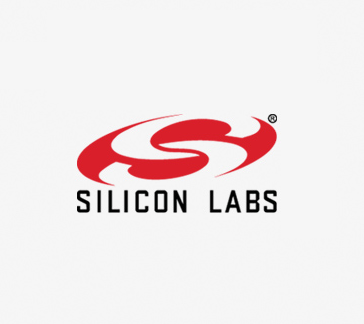




























































































































































































登录 | 立即注册
提交评论